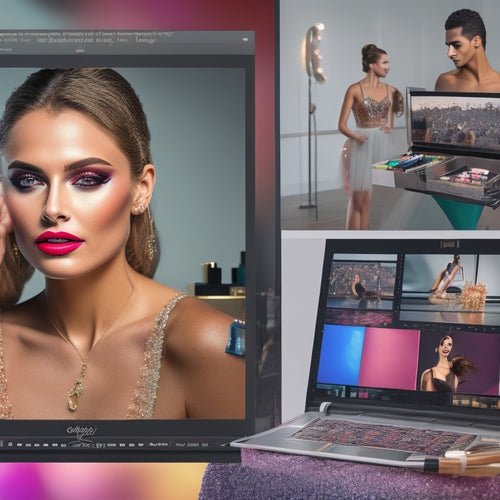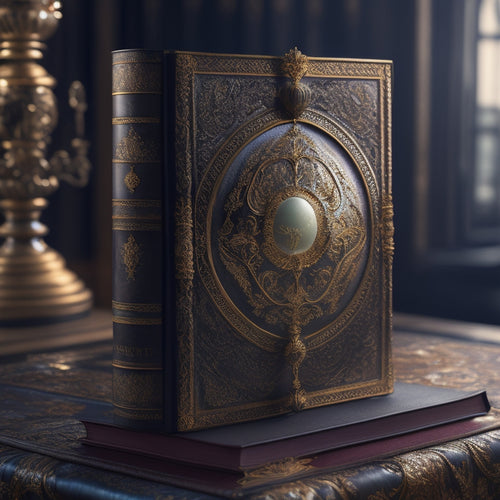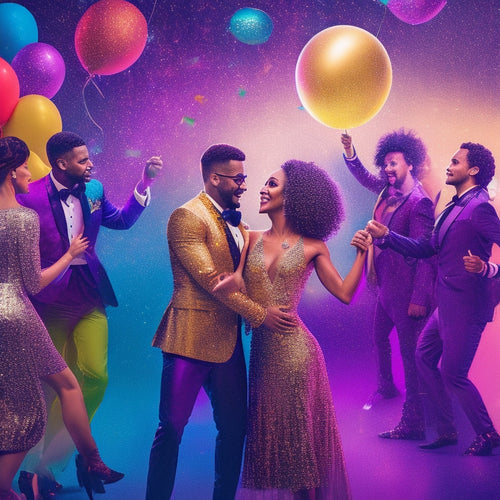
Creating Stunning Portraits With Studio Lighting
Share
To create stunning portraits with studio lighting, you need to become proficient in light manipulation and shadow control. Position your key light strategically to define depth and use fill lights to soften shadows. Experiment with light modifiers like softboxes and beauty dishes for flattering effects. Guarantee accurate color temperature by adjusting your white balance and utilizing gels when necessary. Remember, consistent results come from understanding light direction and ratios. Each adjustment shapes your subject's portrayal, enhancing emotional impact. There's a lot more to investigate about specific techniques and tips that can heighten your work even further.
What You Need to Know
- Master shadow placement techniques to enhance depth and emotional resonance in your portraits.
- Utilize light modifiers like softboxes and beauty dishes for flattering skin tones and controlled shadows.
- Adjust color temperature and white balance to achieve accurate colors and prevent unwanted casts in portraits.
- Experiment with key and fill light positioning to create unique narratives and emotional impact.
- Understand the differences between natural and artificial light to select the best option for your desired outcome.
Enhanced Control Over Shadows
In portrait photography, mastering shadow placement techniques can dramatically alter your images. By understanding how different light modifiers affect shadow characteristics, you can create depth and dimension that enhances your subject's features.
Full body mirrors, for instance, reveal true shape and proportions, encouraging a better understanding of one's body, which can be beneficial when positioning subjects in front of the camera self-acceptance and body awareness.
Let's investigate how to manipulate shadows for stunning visual impact.
Shadow Placement Techniques
Mastering shadow placement techniques is vital for creating stunning portraits, as shadows can dramatically influence the mood and depth of an image.
Start by considering shadow angles; the direction from which your light source comes will define how shadows fall on your subject. For instance, positioning your light high above your subject creates elongated shadows that can add drama, while a lower angle generates shorter, softer shadows that convey intimacy.
Next, think about shadow depth. The closer your light source is to your subject, the more pronounced and stark the shadows will be. Conversely, moving the light further away results in softer shadows that can enhance subtle features.
Experiment with different distances to find the perfect balance.
Don't forget to move your light source around your subject to see how the shadows shift; this experimentation is vital for understanding how various placements affect the overall composition.
By controlling shadow angles and depth, you can sculpt your subject's features, creating striking portraits that connect with emotion and artistry.
Accept the freedom to investigate these techniques, and watch your portraits evolve into captivating visual narratives.
Light Modifier Effects
Using light modifiers can greatly enhance your control over shadows in portrait photography. For instance, softboxes offer significant advantages, softening harsh light and creating pleasing shadows. They're perfect for achieving a natural look without overwhelming your subject.
On the other hand, umbrellas provide extraordinary versatility, allowing you to bounce or diffuse light based on your creative vision.
If you want to highlight facial features, consider using a beauty dish; it strikes a balance between soft and hard light, giving your portraits depth.
For more targeted applications, grids can refine your light source, providing precise grid applications to control shadow intensity.
Ring lights are fantastic for even illumination, minimizing shadows and producing that sought-after catchlight in the eyes.
Reflector types, whether gold, silver, or white, can bounce light back onto your subject, further shaping shadows to your liking.
For dramatic effects, use snoots to focus light narrowly or barn doors to control spill.
Experimenting with diffusion materials can also soften light, shifting it from hard to soft light as needed.
Adopt these tools to wield shadows like a painter, crafting stunning portraits that reflect your unique style.
Improved Color Accuracy
To achieve improved color accuracy in your portraits, excelling in color temperature control is essential.
By adjusting the lighting to match your subject's skin tone, you'll create a more natural and appealing look.
Additionally, incorporating light modifiers can greatly enhance how colors render, ensuring every hue pops with clarity.
Using high-quality fabrics, such as those found in eco-friendly options, can also contribute to a polished appearance, reflecting light beautifully and adding depth to your portraits.
Color Temperature Control
The control of color temperature is essential for achieving improved color accuracy in portrait photography. When you're working in the studio, you'll want to guarantee that the colors in your images are true to life.
Start by setting the correct white balance on your camera. This allows the camera to interpret the light accurately, preventing unwanted color casts that can distort your subject's true appearance.
To further fine-tune your color temperature, consider using lighting gels. These gels can modify the color of your lights, allowing you to match the ambient light conditions or create a specific mood.
For instance, if you're shooting under tungsten lights, apply a blue gel to your strobes to neutralize the warm tones. Conversely, if you're using daylight-balanced lights but want a warmer feel, a gold gel can add that extra warmth.
Light Modifiers Impact
Light modifiers play an important role in enhancing color accuracy within portrait photography. When you use a softbox, you benefit from its ability to diffuse light evenly, reducing harsh shadows and creating flattering skin tones. The soft, wrap-around illumination helps maintain consistent lighting ratios, essential for achieving that perfect balance between highlights and shadows.
Umbrella reflections can also be a significant factor, as they spread light broadly while preserving lively colors. If you're aiming for dramatic flair, consider a beauty dish; its unique design creates stunning highlights and soft rim lighting, emphasizing your subject's features.
Incorporating grid patterns can help you control light spill, directing attention exactly where you want it. Meanwhile, snoot effects can add depth and focus to specific areas, enhancing the overall composition.
Always remember the importance of catchlights in your subject's eyes; they're crucial for adding life to your portraits. By selecting appropriate diffusion materials, you can manipulate the quality of light, ensuring that every detail is rendered with precision.
Adopt these tools, and watch your portrait photography evolve into a lively expression of artistry and emotion.
Light Modifiers Overview
Understanding light modifiers is essential for achieving the portrait lighting you envision. The integration of technology in photography, much like in dance, can enhance your creative expression and allow for innovative lighting techniques.
You'll encounter various types, each offering unique effects that can dramatically change your subject's appearance. By becoming proficient with these tools, you can raise your portraits from ordinary to extraordinary, much like how immersive experiences in performance reshape audience engagement.
Types of Light Modifiers
When it comes to portrait photography, choosing the right light modifier can dramatically affect your final image.
Light modifiers come in various shapes and styles, each offering unique effects on your subject. Softbox shapes, for instance, can create soft, diffused light, perfect for flattering portraits. Umbrella types, whether reflective or shoot-through, are versatile and great for quick setups.
A ring light delivers an even glow, ideal for beauty shots, while a beauty dish provides a focused beam for a more dramatic look. If you want to control light spill, consider using grid patterns to direct light precisely where you need it. Different diffusion materials can soften harsh shadows effectively.
Reflector styles allow you to bounce light back onto your subject, enhancing highlights and reducing contrast. Bounce techniques can brighten dark areas, adding depth to your portraits.
For targeted light, snoot usage narrows the beam, creating striking effects. Finally, a barn door lets you shape the light's spread, giving you even more control over your setup.
Experimenting with these modifiers will help you find the perfect lighting for your portraits.
Effects on Portrait Lighting
The choice of light modifiers greatly influences the mood and depth of your portraits. Each modifier shapes the light differently, directly impacting the lighting psychology behind your images.
For instance, a softbox diffuses light, creating a gentle, flattering illumination that enhances skin tones and conveys warmth. This can evoke feelings of comfort and intimacy, ideal for family portraits or romantic settings.
Conversely, using a grid focuses the light into a tighter beam, casting dramatic shadows that can heighten tension or intrigue. This technique allows for artistic expression, creating powerful, moody portraits that pull viewers in and provoke thought.
Reflecting on the impact of your choices is essential. Experiment with various modifiers to see how they alter the same scene. A beauty dish, for example, can add a striking catch light in the eyes, infusing your portrait with vibrancy and life.
Ultimately, excelling in light modifiers gives you the freedom to sculpt your portraits, crafting unique narratives that connect with your audience. Your manipulation of light not only highlights your subject but also reflects your artistic vision, making each portrait a statement of your creativity.
Selecting Based on Lighting Style
When selecting your lighting style, consider the impact of key lighting techniques on your portrait's mood and depth.
You'll need to decide between natural and artificial light, as each brings its own unique qualities to your subject.
Understanding these elements will help you craft the stunning portraits you envision.
Key Lighting Techniques
Selecting the right key lighting technique is essential for capturing stunning portraits that echo with your subject's personality and mood. Start by perfecting key light positioning; this is your primary source of illumination and should be placed at an angle that creates depth and dimension. Experiment with the height and distance of the light to see how it sculpts your subject's features.
Once you have your key light set, consider fill light usage to soften shadows without overpowering your key light. Fill lights can be positioned opposite your key light or used as bounce lights to reflect softer illumination back onto your subject. This balance enhances your portrait's overall feel, allowing you to control the mood—whether dramatic or soft and inviting.
Don't hesitate to adjust the intensity of your fill light to match your creative vision. Remember, the interplay between your key and fill lights will define the emotions your portrait conveys.
Natural vs. Artificial Light
Natural light offers a unique quality that can enhance your portraits in ways artificial light sometimes can't match. When you choose natural light, you're tapping into the beauty of ambient lighting, especially during golden hour. This soft, diffused light creates flattering shadows and highlights, perfect for outdoor shooting.
However, capturing the right mood requires attention to light direction and exposure adjustment.
On the other hand, artificial light gives you control in a studio environment. With the right lighting equipment, you can create consistent daylight balance, allowing you to craft the scene you envision. You can manipulate light direction to sculpt your subject's features, achieving mood enhancement that natural light mightn't provide in every scenario.
Ultimately, your choice between natural and artificial light depends on your desired outcome. If you're after the organic warmth and vibrant range of natural light, go outdoors and welcome the elements.
But if precision and repeatability are your goals, invest in quality artificial lighting. Both methods have their merits; it's all about how you wield them to express your artistic vision.
Consistent Results in Diverse Conditions
To achieve consistent results in diverse conditions, perfecting light placement techniques is essential.
You'll want to understand how to manipulate your light sources strategically, ensuring your subject always appears flattering, regardless of the environment.
Incorporating lighting strategies can further enhance your skills, making it easier to adapt to varying settings.
With practice, you can create breathtaking portraits that shine in any setting.
Mastering Light Placement Techniques
In portrait photography, perfecting light placement is essential for achieving consistent results, regardless of varying conditions. Understanding light direction and controlling lighting ratios allows you to create depth and dimension in your portraits.
To help you visualize effective light placement, here's a quick reference table:
| Light Direction | Example Scenario |
|---|---|
| Front Lighting | Soft, flattering features |
| Side Lighting | Dramatic shadows and texture |
| Back Lighting | Silhouettes and highlights |
When positioning your lights, consider the desired mood and impact. For instance, front lighting can soften facial features, while side lighting enhances textures and contours. Experiment with different lighting ratios to balance highlights and shadows, ensuring your subject pops without losing detail.
Frequently Asked Questions
What Types of Studio Lights Are Best for Beginners?
For beginners, softbox options and LED lights are ideal. They provide soft, diffused light, making it easier to control shadows. Start with a basic setup, and you'll feel enabled to experiment and create stunning images.
How Do I Set up My Lighting for Group Portraits?
To set up your lighting for group portraits, consider group interactions. Use a three-point lighting setup, positioning key, fill, and backlights strategically to create depth and warmth, ensuring everyone's features are beautifully highlighted.
Can I Use Natural Light With Studio Lighting Techniques?
You can absolutely blend natural light with studio techniques. Welcome the soft glow of sunlight, enhancing your setup. This harmony enhances your portraits, creating depth and inviting a warm atmosphere that charms your audience.
What Are Common Mistakes to Avoid in Portrait Lighting?
When lighting portraits, avoid common mistakes like improper lighting angles and poor shadow control. Guarantee your light source is positioned to create flattering shadows, enhancing your subject's features and achieving a more energetic, engaging image.
How Do I Maintain My Studio Lighting Equipment?
To maintain your studio lighting equipment, regularly check connections and clean bulbs. Use proper cases for transport, avoid moisture, and perform light maintenance to guarantee longevity. Consistent care keeps your gear ready for creative freedom.
Explore More
So, if you're ready to turn your subjects into glamorous gods and goddesses, remember: shadows are your trusty sidekicks, and light modifiers? They're the fairy godmothers of the studio! Forget the chaos of natural light; who needs the sun when you can wield precise control like a lighting virtuoso? With consistent results, you'll be the portrait Picasso, crafting masterpieces in any setting. Now go forth, and may your lighting be ever in your favor—just don't blind your subjects!
Related Posts
-

Learn Dance Makeup Artistry Online: A Step-by-Step Guide
You're about to begin an exciting journey to master the art of dance makeup online! First, you'll need to select the ...
-

The King Manual: Your Ultimate Knowledge Companion
The King Manual: Your Ultimate Knowledge Companion is an all-encompassing resource that opens up the power of knowled...
-

Master Pattern Dances for Social Fun
Mastering pattern dances for social fun requires a deliberate blend of technical skill, teamwork, and practice, yield...


